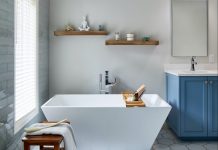 As the founder and principal of Fusion Designed in Forest Lake, Sheree Vincent, Allied ASID, was an expert on home as sanctuary way before the COVID-19 pandemic and stay-at-home directives. For more than 25 years, she’s deployed her expertise in both sustainable design and Feng Shui to help her clients transform their homes into “the ultimate sanctuary.”
As the founder and principal of Fusion Designed in Forest Lake, Sheree Vincent, Allied ASID, was an expert on home as sanctuary way before the COVID-19 pandemic and stay-at-home directives. For more than 25 years, she’s deployed her expertise in both sustainable design and Feng Shui to help her clients transform their homes into “the ultimate sanctuary.”
We asked Vincent how, as we continue to stay safe at home, we can improve our interior spaces to better support our mental and physical health, as well as our calm. Here’s her time-tested, invaluable advice on introducing biophilic design and Feng Shui elements into the home, both of which are timely to consider.
Biophilic Design

“We have a genetic connection to the natural world,” Vincent says, meaning that by incorporating elements of nature into our homes, we’ll feel more connected to peace. This is called biophilic design. “By definition, biophilia means a love of life and the living world; the affinity of human beings for other life forms. Biophilic design creates a strong relationship between nature and human-made environments. Introducing biophilic designs into your home improves your physical and mental health and your productivity, and reduces stress.”
Vincent’s easy tips for incorporating biophilic elements into your home include:
-
 Introducing more live plants (even cut flowers) into the home. Studies show that indoor plants boost mood, concentration and creativity; reduce stress and fatigue; and clean indoor air by absorbing toxins, increasing humidity, and producing oxygen.
Introducing more live plants (even cut flowers) into the home. Studies show that indoor plants boost mood, concentration and creativity; reduce stress and fatigue; and clean indoor air by absorbing toxins, increasing humidity, and producing oxygen. - Purchasing artwork that immerses you in nature. Whether you’re partial to photographs, botanical drawings, or abstract art, local artists and galleries will be happy to work with you virtually to purchase a piece of art that brings nature indoors.
- Opening up the curtains and windows. Bring daylight and birdsong inside your home to stimulate your senses.
- Incorporating fabrics on furnishings and accessories made from such natural fibers as cotton, wool, flax linen, and hemp.
- Introducing patterns, textures, and accessories that reflect or replicate nature, from birch-bark baskets to floral prints.
- Painting a wall a color that brings the outdoors in, using no-VOC paint, milk paint, or natural clay-based finish.

Feng Shui
“In her book Conversations with Your Home, my Feng Shui instructor Carole Hyder writes that, “A home is the place that lets you be you, that knows you well, that knows you at your core. A home holds the template of our thoughts. As our thoughts change, so does our home; as home changes, so do our thoughts. I believe this encapsulates what we are all feeling and going through right now.”

Feng Shui, a 4,000-year-old practice, focuses on the energy of our spaces and how to be in harmony with it, Vincent adds. The four principles are: everything is energy; your space mirrors your life; use nature as your model; and intention is key.
Vincent’s tips for introducing better Feng Shui into your home include:
- Reducing clutter. “The word is derived from the Middle English ‘clotter,’ meaning coagulate,” she explains. “Clutter is stuck energy that affects our well-being. It stops us from moving forward, and can cause confusion and a feeling of being overwhelmed.” She advises to start small, with one drawer, closet, or countertop. Think about reducing or eliminating “things you do not use or love, things that are not tidy or are disorganized; too many things in too small a space; and anything unfinished.” Then move onto to a larger space or de-cluttering project.

- “Bedrooms are rooms of relaxation, rest, healing, and intimacy,” she says. “It’s the most influential room in our home and can impact our outlook on life. It’s important to surround ourselves with items we love as they are the first and last things we will see each day.” The bedroom, then, should be free of televisions and other technologies or distractions, as well as exercise or office equipment. “These items contain lots of energy and our bedrooms should be quiet and calm sanctuaries.” She also suggests hanging “a favorite piece of artwork at the foot of your bed to create a vision wall that brings joy and happiness to you as you awaken.”

Photos courtesy Fusion Designed




















